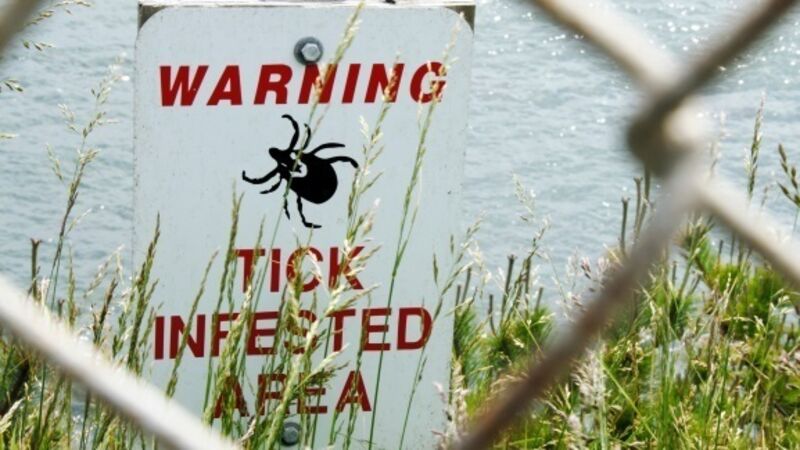Ireland's deer are not to blame for humans contracting Lyme disease

THESE days, if you’re not an outdoorsy sort of person, you’re essentially a discard. Everybody’s out hillwalking, running, Ironmanning. Except me. I believe if God wanted us to do that sort of stuff, She wouldn’t have allowed the invention of 4in high heels, which, let’s be honest, are the essentials of a decent life.
Normally, I tolerate all the predictions that my sedentary life will cause me to die young (not possible for a long time now) and that my work/life balance would be so much better if I got out into the country, saw a few trees and encountered a few rabbits. My view has always been that once you’ve seen one tree you’ve seen them all. And anything that can breed — as rabbits did in Australia — so they go from 2m to 6m in 10 years is so irresponsible that you don’t want to get up close and cosy with them.
The HSE last week handed us sedentaryists the best-ever excuse for nature-avoidance in a warning about Lyme Disease. Now, that’s one disease I’m never going to get, because the chances of me encountering a tick in the wild are somewhere between slim and none. Lyme disease is a bacterial infection that is spread to humans by infected ticks.
Ticks are small, spider-shaped creatures that feed on the blood of mammals, including humans.
I remember my sister, who is naturally outdoorsy, coming home with a tick once and being told that you should never pull out a tick because its legs would stay in you. Instead, a lit match externally applied to it would make it let go. If this approach was adopted, it was concealed from me, perhaps because it would have traumatised me as well as irritating the hell out of the tick.
According to the HSE, the most common symptom of Lyme disease is a red skin rash that looks similar to a bull’s eye on a dart board. If Lyme disease is left untreated, a high fever, muscle pain, joint pain, and swelling ensue. In addition, neurological symptoms can present, such as temporary paralysis of the facial muscles. Now, the good news is that fewer than 100 cases happen in this country each year, mostly in late spring and early summer, and also that antibiotics administered early in the infection can be effective.
The ticks causing Lyme disease tend to hang around woodland and heathland areas, where animals such as mice, deer, and sheep become infested with these lads, which seem to be only egging to leap from their carriers to grip on to and infect outdoorsy humans. The issue, of course, is that the humans should have more sense.
Rick Ostfeld of the Cary Institute of Eco-system Studies in Millbrook, New York, who has for decades studied Lyme disease, says that it’s an ecological, not just a medical problem.
“Lyme disease in humans exists,” he says, “because we are sort of unwitting victims of a wildlife-tick interaction. We’re interlopers into this system where ticks and these hosts — the reservoir hosts — pass bacterial infections back and forth.”
In other words, if we were sensible and stayed at home, we wouldn’t be getting the disease at all. In fact, if Americans over the past couple of decades had been sensible and stayed at home, thousands of beautiful deer would not have been exterminated.
Because, according to science writer David Quammen’s seminal book about the diseases that increasingly spill over from the animal kingdom to infect humans, that’s exactly what happened.
Bambi was in danger the moment the most dangerous tick was given a complicated name. It didn’t stick. Complicated names rarely do. People simplified it so that it was known as the deer tick.
“Name-giving influences perception, of course, and ‘deer tick’ reinforced a misunderstanding about the little beast in question: That this blood-sucking, disease-transmitting arthropod is somehow uniquely associated with deer,” Quammen’s writes, pointing out that this is quite simply wrong.
“Calling it the ‘deer tick’ led to a mistake of circularity. If white-tailed deer are the host animals from which ‘deer ticks’ draw their crucial substance, and ‘deer ticks’ are the vectors that transmit Lyme disease to humans, it would seem to follow logically that high deer populations must contribute to high levels of human infection.
It does follow logically — but erroneously.
The syllogism would be sound, except that its first premise is oversimplified and misleading.
‘Deer ticks’ of the species Ixodes scapularis do not draw their crucial sustenance from deer.
None of that logic applied once the simple assertion took hold that humans get Lyme disease from ticks they get from deer. Instead of looking at issues of protection or addressing the danger of humans disrupting the complex ecology of woodlands by invading them for walking or hunting purposes, the argument boiled down to one cause and one species attracting all blame. That cause and that species was the white-tailed deer.
It presented a possible solution that called for action. The action took the form, in one small island off Cape Cod, of state wildlife biologists going out with guns and destroying 70% of the deer.
Having untypically killed off a large proportion of the beautiful animals on the island, the biologists, fair dues to the murdering lot of them, went on to check if this extermination had delivered a measurable reduction in the tick population carried by the other wildlife in the island.
They found that it had made damn all difference. In other words, outdoorsy types on the island were just as likely to acquire a Lyme-disease infected tick in the now largely deer-free woods as they were before the deer were killed. All of the other animals carried just as many of the bugs as ever they did.
However, the notion that white deer effectively caused the disease had taken hold in rural America to such an extent that one state after another actively encouraged intensive deer hunting, with the objective of radically reducing deer populations.
In went the hunters. Bang went the guns. Down went the deer. And, in one state after another, in went the biologists after the massacre to assess the impact on the infected tick population, finding the same picture everywhere.
Despite all of the scientific evidence, one leading newspaper stated as incontrovertible that “the higher the number of deer in an area, the higher the chances are of spreading Lyme disease to humans”.
To which statement Quammen responded: “Well, actually, no. That simple formula is a false as the notion that swamp vapours bring malaria.”
Here in Ireland, nobody has yet blamed Lyme disease on our deer. Perhaps because HSE has given such calm advice on how to prevent yourself from becoming infected: Cover up and wear insect repellent.
Of course, you could also buy yourself a set of weights and work out at home, thereby sparing yourself any opportunity to be introduced to a tick.












